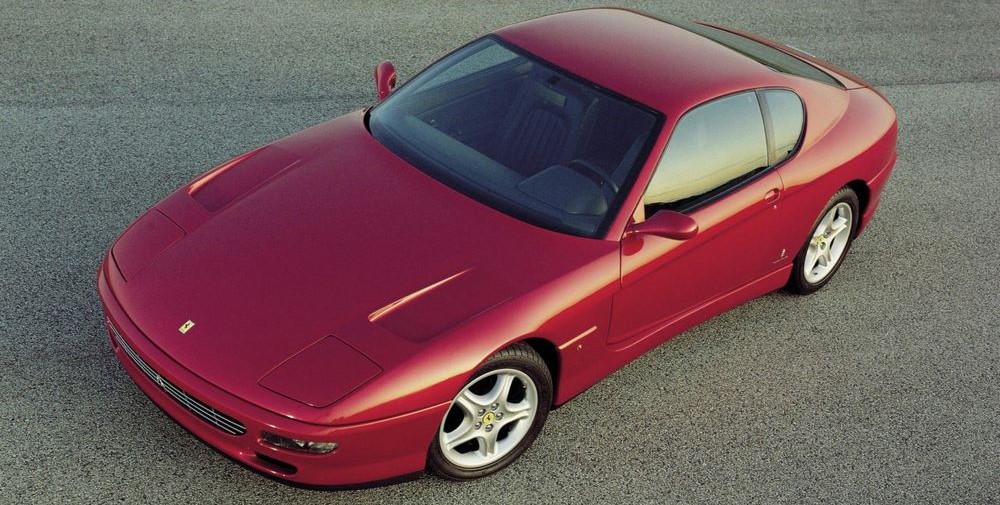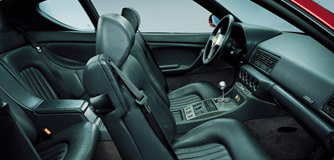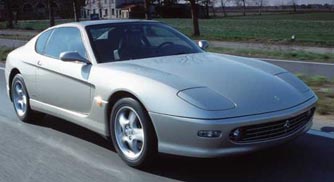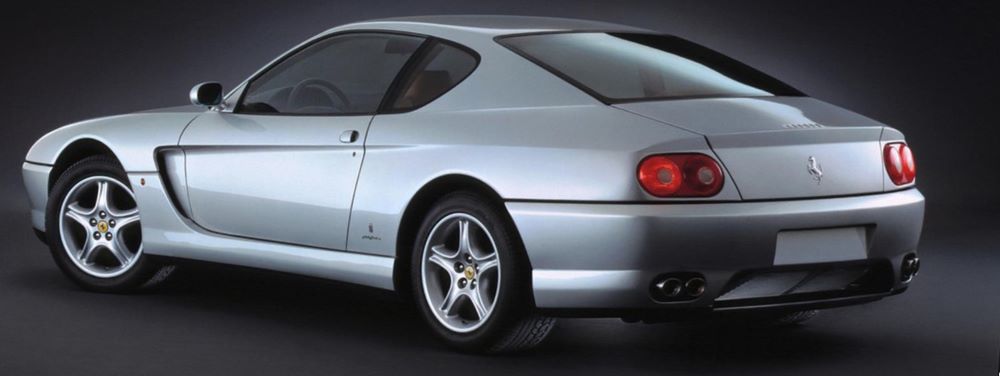
Ferrari 456 GT (1992)
The 456 GT took the luxury 2+2 coupé theme to new heights and saw Ferrari return to the front-engine concept for the first time since the 1968 365 GTB4. The all-new 65° V12 provided unprecedented flexibility and power. The aluminium bodywork designed by Pininfarina was aerodynamic, efficient and indisputably elegant, unequivocally conveying the model’s identity as a Ferrari.
Cockpit ergonomics meant passengers enjoyed high levels of comfort: the 456 GT set the standard for its class.
 After a three year period without a V12 engine 2+2 model in the range, the 456 GT was announced on the occasion of Ferrari’s then Belgian concessionaire’s fortieth anniversary in September 1992, making its public show debut in Paris the following month. As part of the Garage Francorchamps anniversary celebrations, the new model was launched at a gala dinner in the Palais de Cinquantenaire in the centre of Brussels. This was a positive and brave move by the company, as the classic, luxury, and prestige sports car markets were in deep recession, after all the speculation and hype of the late eighties. However, they showed their commitment to broadening their range, and to maintaining their position at the head of the list of the world’s most desirable automobiles.
After a three year period without a V12 engine 2+2 model in the range, the 456 GT was announced on the occasion of Ferrari’s then Belgian concessionaire’s fortieth anniversary in September 1992, making its public show debut in Paris the following month. As part of the Garage Francorchamps anniversary celebrations, the new model was launched at a gala dinner in the Palais de Cinquantenaire in the centre of Brussels. This was a positive and brave move by the company, as the classic, luxury, and prestige sports car markets were in deep recession, after all the speculation and hype of the late eighties. However, they showed their commitment to broadening their range, and to maintaining their position at the head of the list of the world’s most desirable automobiles.
The smooth rounded lines from the pen of Pininfarina drew praise from all sides, particularly the modernised reflection of the fabled 365 GTB/4 “Daytona” with the long bonnet, featuring retractable headlight pods, running into a set back cabin. Also inspired by the “Daytona” was the design treatment of the rear of the cabin envelope and tail. Thus although the shape was thoroughly modern, it contained retro trace elements to associate it with the company’s history. One aerodynamic element that was almost imperceptible was the electronically activated spoiler below and within a cut-out in the rear valance, whose angle changed relative to road speed to increase downforce. As with all the other models in the range at the time, it was designed as a world market car from the outset, and perhaps most importantly there was an USA market model. However, where the preceding 2+2 models had been offered with automatic transmission, the 456 GT was initially only available with a manual gearbox. Here there was another analogy with the “Daytona”, as it had the gearbox mounted in unit with the differential and final drive assembly, forming a transaxle.
 The bodies were mounted on a 2600mm wheelbase chassis, which was 100mm less than the 412 2+2 model, with a front track of 1585mm and rear track of 1606mm. It was constructed in the traditional steel tube fashion, incorporating substructures to support mechanical and body components, bearing factory type reference F 116 CL. All were numbered in the continuous chassis number road car sequence in the range 96157 to 111376, and the production period spanned 1992 to 1998, during which time 1548 examples were produced. The model was available in right or left hand drive form, with power assisted steering as standard. The majority of the body panels were aluminium, welded to the steel frame via a specially formulated sandwich material called Feran, which was chemically treated to permit the welding of the two dissimilar metals, whilst the front and rear valances were composite mouldings
The bodies were mounted on a 2600mm wheelbase chassis, which was 100mm less than the 412 2+2 model, with a front track of 1585mm and rear track of 1606mm. It was constructed in the traditional steel tube fashion, incorporating substructures to support mechanical and body components, bearing factory type reference F 116 CL. All were numbered in the continuous chassis number road car sequence in the range 96157 to 111376, and the production period spanned 1992 to 1998, during which time 1548 examples were produced. The model was available in right or left hand drive form, with power assisted steering as standard. The majority of the body panels were aluminium, welded to the steel frame via a specially formulated sandwich material called Feran, which was chemically treated to permit the welding of the two dissimilar metals, whilst the front and rear valances were composite mouldings
The standard road wheels were stylised renditions of the traditional five spoke “star” alloy design, featuring elegant convex spokes and five bolt fixing. Independent suspension was provided all round, with front and rear anti roll bars, and electronically operated driver controlled variable shock absorber settings, plus hydraulic self levelling rear suspension. The adjustable dampers were provided with an electronic “brain” that monitored various factors, like steering angle, road speed and acceleration, to optimise the settings for the driving conditions. The steering was power assisted, the degree of assistance varying with road speed, being greatest at parking speeds and diminishing with an increase in velocity. Four wheel ventilated disc brakes were provided, and equipped with an ATE Mark IV Antiskid system, to minimise loss of traction under extreme conditions
 The engine was completely new, the first brand new 12 cylinder unit since the flat twelve “Boxer” unit some two decades earlier, with factory type reference 116 B, and then 116 C. It also marked a return to the old tradition of the model designation number (456), relating to the approximate swept volume of a single cylinder in cubic centimetres. Previous production V12 engines had a 60 degree angle between the cylinder banks, unless you think of the flat twelve “Boxer” engine as an 180 degree V12, whereas the new motor had an angle of 65 degrees. The total cubic capacity was 5474cc, with a bore and stroke of 88mm x 75mm, four valves per cylinder, twin overhead camshafts per bank, and dry sump lubrication. The block, cylinder heads, sump, and sundry castings were constructed from light alloy, featuring Nicasil treated alloy cylinder liners. A Bosch Motronic 2.7 combined fuel injection/ignition engine management system was fitted initially fitted, superseded by a Motronic 5.2 unit in 1996, which fed the air/petrol mixture to the engine through beautifully sculpted cast alloy intake boxes and manifolds atop the engine, to provide a claimed power output of 442bhp at 6200rpm. The complete transmission system was also entirely new, featuring the provision of an all synchromesh six speed transaxle gearbox for the first time on a Ferrari road car. However, the principle of the transaxle, with its benefit to weight distribution was not new to Ferrari, as it had been used successfully on the 275 GTB and “Daytona” models some twenty five plus years earlier.
The engine was completely new, the first brand new 12 cylinder unit since the flat twelve “Boxer” unit some two decades earlier, with factory type reference 116 B, and then 116 C. It also marked a return to the old tradition of the model designation number (456), relating to the approximate swept volume of a single cylinder in cubic centimetres. Previous production V12 engines had a 60 degree angle between the cylinder banks, unless you think of the flat twelve “Boxer” engine as an 180 degree V12, whereas the new motor had an angle of 65 degrees. The total cubic capacity was 5474cc, with a bore and stroke of 88mm x 75mm, four valves per cylinder, twin overhead camshafts per bank, and dry sump lubrication. The block, cylinder heads, sump, and sundry castings were constructed from light alloy, featuring Nicasil treated alloy cylinder liners. A Bosch Motronic 2.7 combined fuel injection/ignition engine management system was fitted initially fitted, superseded by a Motronic 5.2 unit in 1996, which fed the air/petrol mixture to the engine through beautifully sculpted cast alloy intake boxes and manifolds atop the engine, to provide a claimed power output of 442bhp at 6200rpm. The complete transmission system was also entirely new, featuring the provision of an all synchromesh six speed transaxle gearbox for the first time on a Ferrari road car. However, the principle of the transaxle, with its benefit to weight distribution was not new to Ferrari, as it had been used successfully on the 275 GTB and “Daytona” models some twenty five plus years earlier.
The interior was sumptuously upholstered in leather as standard, with electronic adjustment facilities for the front seats, which slid forward automatically when the catch was released to afford access to the rear. The rear seats provided adequate space for adults in comfort, with good headroom, and adequate legroom for most people. Because of their location relative to the side windows, rear seat passengers were provided with good visibility, without feeling confined by the rear pillars. A range of fitted leather luggage was provided as standard to maximise the boot space. Electric windows and door mirrors, a stereo system with CD player and eight speakers, plus air conditioning, were further standard features of the model. In mid 1996 twin airbags became a standard fitment, with a redesigned steering wheel to incorporate the driver’s unit.

456 GTA (1996)
This was the automatic version of the 456 GT. Supplied as an option on the 400 Automatic from 1976, the automatic transmission was very popular and much in demand on the North American and Pacific markets. The 4-speed gearbox’s electronic management system adapted automatically to different driving styles, dispensing with the need for a kick-down mode.
The transaxle layout maintained the GT’s near ideal weight distribution, and an innovative torque converter ensured virtually identical acceleration and top speed to the manual version.
This 2+2 Coupé 2+2 continued the great Ferrari Grand Tourer tradition. Penned by the legendary Pininfarina, the 456 GTA was an entirely original design whose sleek forms were shaped around its front engine and rear-mounted gearbox-differential assembly. The 456 GTA combined benchmark 2+2 performance with the kind of comfort and liveability expected by Ferrari clients looking for a very versatile sports car. Particular attention was lavished on its aerodynamics to ensure maximum efficiency in all kinds of conditions. A retractable wing integrated into the rear bumper changed angle as speed changed.
The 456 GTA had an aluminium and feran bodyshell with composite engine bay and retractable headlamp covers with honeycomb insert.
The Connolly leather-trimmed cabin had four seats. The driver position included seat and steering wheel controls as well as climate control and stereo buttons. A five-piece bespoke luggage set fitted neatly into the boot.
The 456 GTA had a tubular steel spaceframe chassis. It featured independent suspension on all four wheels with coil springs and telescopic dampers front and rear with three calibration settings that could be selected manually. There were both front and rear stabiliser bars too. The steering was rack and pinion (Servotronic) while the ventilated disc brakes had the ATE mark IV 4-channels ABS system.
The longitudinal front-mounted 65° 5,474 cc V12 punched out 442 hp. The four valves per cylinder were controlled by twin overhead cams. It also featured Bosch Motronic 2.7 engine management and dry sump lubrication. The car had a four-speed (plus reverse) automatic gearbox in unit with the rear-mounted self-locking differential (transaxle).

456M GTA (1998)
The 456M, in its GT and automatic gearbox GTA guises, is the evolution of Ferrari’s highly successful interpretation of its traditional 2+2 models. First introduced in 1992, the 456 GT was the marque’s first car designed with the 21st century in mind and has been much appreciated by Maranello’s clients for the way it provides saloon-class comfort and roominess combined with class-leading performance and all-round ability.
A true four-seater coupé, the 456 GT was also the first modern Ferrari to revert to a front engine, rear-wheel drive layout, with the gearbox in unit with the rear differential for ideal weight distribution as well as plenty of space for passengers and luggage.
456M GTA
- Performance
- Top speed……………….over 298 km/h
- Acceleration
- 0-100 km/h………………5.5 sec
- 0-400 m………………….13.6 sec
- 0-1000 m…………………23.7 sec

456M GT (1998)
The GT version of the 456M complete with six-speed plus reverse manual gearbox was an evolution of a model that proved particularly popular with owners that wanted an authentic Ferrari that was still capable of seating four and very versatile to boot. Continuing the marque tradition in the 2+2 sector, the Pininfarina-designed 456M GT combines the blistering performance of a 5.474 cc V12 with the comfort and liveability of grand tourer.
A front-mounted engine and rear-mounted gearbox was the most rational choice to achieve more cabin space and benchmark driveability and safety. Particular attention was lavished on the car’s aerodynamics yielding a clear front design and involving the adoption a retractable wing integrated into the rear bumper. Front axle life was optimised by the specific shape front bumper spoiler and bonnet as well as work done on the rear diffuser.
The 456 M GT had a tubular steel chassis to which light aluminium panels were spot-welded using a specially-treated foil known as Feran. This meant that the chassis had both the lightness of aluminium and the stiffness of steel. To keep weight down, the front bonnet was carbon-fibre.
The four-seater cabin was trimmed in Connolly leather. The seats were electronically adjustable with position memory. The instruments were analogue with multiple gauges. The 456 M GT also sported a fully automatic climate control system with solar radiation sensor, and stereo system.
The tubular steel spaceframe chassis was linked to four-wheel independent suspension with stabiliser arms and double wishbones with antidive geometry. The electronically-controlled gas dampers had two settings. The Servotronic power-assisted was rack and pinion while the brakes had four ventilated discs with ABS and an electronic rear brake corrector. The car also featured an evolved ASR traction control system linked to the antiskid system which greatly improved safety even in the trickiest of conditions.
The 442 hp 5474 cc front 65° V12 was longitudinally mounted. It had four valves per cylinder with twin overhead cam distribution. The engine management system was the Bosch M5.2. There was also dry single-plate clutch and dry sump lubrication. The 456M GT had a six-speed plus reverse mechanical gearbox.
456M GT
- Performance
- Top speed……………….over 300 km/h
- Acceleration
- 0-100 km/h………………5.2 sec
- 0-400 m………………….13.3 sec
- 0-1000 m…………………23.3 sec

You must be logged in to post a comment.